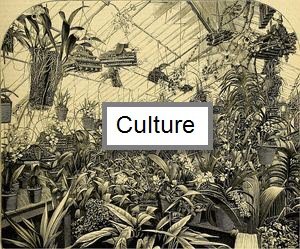Orchid Flowers with a Painterly Touch Garner Praise
FOR MANY, PURE WHITE FLOWERS of most any type represent floral perfection. There seems to be something unique and captivating about a white or alba bloom. Arguably, the absence of color allows us to appreciate a blossom’s form without the distraction that color can impart.
However, white flowers can be tricky to use in gardens, arrangements and displays. While some have suggested that white can bring a calming effect, others believe it tends to enliven and excite when blended with other hues. I belong to the latter camp.
The exhibits at orchid shows provide a good example. White flowers are usually relegated to the upper reaches of orchid displays, as if floating toward the clouds, while darker and stronger colors are typically employed at lower levels. The exhibit designer who mixes patches of white flowers among the other colors will usually come off with a distracting, if not garish result.
Perhaps the idea that shades of white often seem to work best when blended and compared with each other was part of the rationale that prompted the late writer Vita Sackville-West to design her famous white garden at England’s Sissinghurst Castle. She and other garden designers have appreciated that white flowers combined with plants sporting silver and variegated foliage can create a masterpiece by moonlight. Yet it is often the case that those same gardens can appear pitifully pale in the heat of day.
Truth be told, white flowers have never been favorites of mine. Certainly, a quality specimen of a white cattleya or phalaenopsis is a thing of beauty, but as I gaze on them, I often feel that something is missing. Perhaps too, it is related to the lifeless tan or parchment hue that many white blossoms assume as they fade.
On the other hand, I am a great fan of what are popularly called semi-alba orchids — those that produce white flowers with colored lips. The lips of most semi-alba orchids are some variation of red or purple. To surround such a vividly colored orchid lip, usually its most distinctive and attractive feature, with white sepals and petals, seems inspired and magical. Indeed, Mother Nature designed in a most painterly fashion when creating this color scheme.
The semi-alba style of flower occurs naturally in some orchid species that have a wide variation in floral expression, even though the oc-currence of the semi-alba form may be a rarity. Among the traditional unifoliate Cattleya species, a number were found to have semi-alba forms or varieties, including Cattleya lueddemanniana, Cattleya mossiae, Cattleya jenmanii and Cattleya labiata. Dendrobium kingianum, Lycaste skinneri and Sophronitis (syn. Laelia) purpurata are other orchid species that occasionally produce semi-alba examples. Leptotes bicolor is a good representative of a species orchid where most individuals produce flowers of semi-alba coloration (see story on page 486). Some Cochleanthes species and hybrids produce individuals with flowers that also would best be described as semi-alba. Curiously, there are some rather striking examples of what could be described as more or less semi-alba blossoms among certain species of the slipper orchids, including Cypripedium reginae and Paphiopedilum delenatii.
Semi-alba orchid hybrids have always enjoyed popularity. Cattleya (syn. Laeliocattleya) Persepolis (Kittiwake × Pegi Mayne), Cattleya (syn. Laeliocattleya) Shellie Compton (Stephen Oliver Fouraker × Good Fairy), Cattleya (syn. Laeliocattleya) Stephen Oliver Fouraker (Pegi Mayne × Enid) and Cattleya (syn. Laeliocattleya) Mildred Rives (Rita Renee × Bou Philippo) are among the semi-alba hybrid cattleya classics. There are numerous con-temporary hybrids as well. Some of the semi-alba cattleya hybrids have yellow coloration on the interior of the lip as well as occasional faint coloration on the floral segments.
The same may be said for the semi-alba phalaenopsis. Many growers find that the white Phalaenopsis and Doritaenopsis hybrids with red lips are among the most beautiful of all orchids. Indeed, a well-arranged cascade or spray of such blossoms is difficult to overlook. Other vandaceous orchids produce the semi-alba flower. The hybrid Vascostylis Five Friendships ‘Sweetheart’, FCC/AOS (Seng × Prapin), is an excellent example.
Even more beautiful are well-grown semi-alba orchids, particularly some hybrids. Lots of pristine flowers with dark, contrasting lips of red or wine coloration make a dazzling sight. In displays, semi-alba flowers can be even more troubling than white flowers to place properly because their appearance can be so commanding. Often the best solution is to arrange them in proximity to the whites. Happily, it is a problem many orchid growers welcome, as the semi-alba orchid is among the most intriguing and popular of all.
